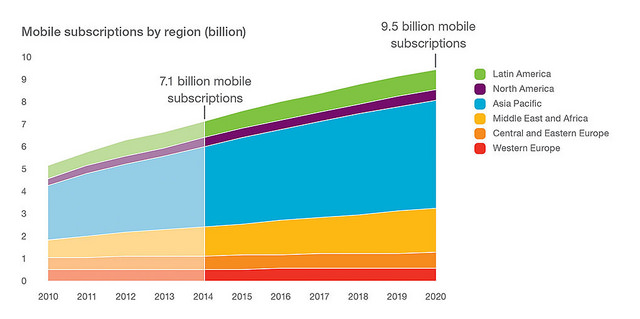
By the year 2020, 90 percent of the world’s population over 6 years of age will have a mobile phone, making them candidates for mobile payments, according to the annual Mobility Report that Swedish networking giant Ericsson released this month.
By the year 2020, 90 percent of the world’s population over 6 years of age will have a mobile phone, making them candidates for mobile payments, according to the annual Mobility Report that Swedish networking giant Ericsson released this month.
Already there are 2.7 billion smartphone subscriptions, with an estimated 800 million new subscriptions in 2014 — more than a 40 percent growth rate — and the total number of smartphones in use is projected to hit 6.1 billion in 2020, the report said. That would mean 80 percent of the world’s population will be smartphone users in six years.
Smartphones currently account for just 37 percent of mobile phone subscriptions, but they also represent more than 65 percent of new mobile phones sold worldwide. Among all mobile phones, the fastest growth rates are in India and China, which gained 18 million and 12 million net new mobile subscriptions just in Q3 of 2014. Users in the Asia Pacific region now represent just over half of all mobile phones in use, and an even larger proportion of smartphones.
Rima Qureshi, Chief Strategy Officer and Head of M&A for Ericsson attributed the climb in smartphone adoption rates to the falling cost of handsets, improved usability and wider network coverage.
Much of Ericsson’s report is focused on the rise of video on phones, which the networking company said will represent 55 percent of all network traffic by 2020. That’s not a surprising preoccupation for Ericsson, since it controls about one-third of the global market for wireless networks, the Wall Street Journal reported.
However, the rapid increase in the number of mobile users — and especially smartphone users — in the underdeveloped world is also likely to have a huge impact on financial inclusion. SMS-based financial services like Safaricom’s M-Pesa have already made branchless banking, loans and money transfers a reality in rural areas where there’s none of the infrastructure required for traditional banking.
But text-message-based payments are inherently less secure than other payment-messaging systems that require more bandwidth and phone processing power. With the shift to smartphones, encryption and multifactor authentication will become practical, increasing the security and potentially spurring new financial services.
Worldwide, Ericsson said, there was a 60 percent increase in mobile data traffic from the third quarter of 2013 to the same period in 2014. Voice call traffic stayed flat.
Ironically, while the network bandwidth required for mobile payments is a small fraction of what mobile video will consume, it’s likely to be bandwidth-hungry video that will continue to push the buildout of mobile networks, both for speed and geographical reach. That’s already happening in tandem with smartphone growth: Ericsson said that worldwide there was a 60 percent year-over-year increase in mobile data traffic from 2013 to 2014, while voice call traffic remained flat.